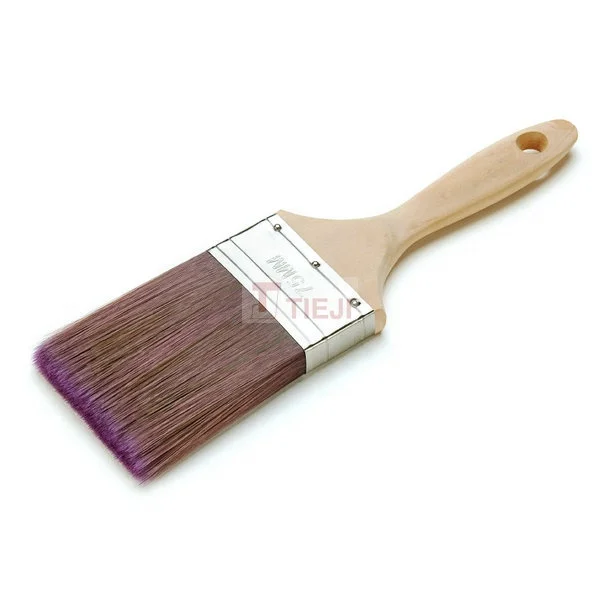'They can be found in nylon, a nylon and polyester blend, and Chinex. Nylon is a soft and fine filament and feathers paint well. In combination with polyester, it has a firmer feel and can help you spread a heavier paint. The firmness is usually marked on the paper wrapper, to which I always return a brush at day's end to preserve the shape. Natural bristles are made from some sort of animal hair, such as hog or badger. Synthetic bristles are often made from nylon, polyester, or a combination of both. Natural-bristle brushes are best. PXPRO PX02573 3PC Nylon/Polyester Brush Set 1. 4.4 out of 5 stars27. Get it as soon as Mon, Apr 5. FREE Shipping on orders over $25 shipped by Amazon. Paint Brushes for Walls,4 Inch Deck Stain Brush,Polyester Stain Brush, Fence Brush, Ceiling Brush,Professional Painters Paint Brush for Paint for Floor and Fence,House Paint Brush-5 Piece.


There are paint brushes made for oil based products and brushes for water-based products. Brushes come in a variety sizes, shapes, handle types and of course, different qualities. Choosing the right brush will make your work easier, faster and better.
Bristle Type
Natural bristles typically are made with animal hair. Chinese bristle is usually made with hog's hair or ox hair. They are best for oil based paints, varnishes, shellacs, and other finishes. Natural bristles should never be used with water based (latex) paints. The water is absorbed by the natural bristle and causes the brush to swell up. Natural bristles develop splits in the tip (flagging) which results in smoother application of the paint and thus fewer brush strokes.
Synthetic bristles include nylon, polyester and nylon/polyester blend. Four seasons baroque. A synthetic bristle is the proper choice for water based (latex) paints. Nylon and nylon/poly blend brushes can be used for oil or water based paints, but a polyester brush is best suited only for latex paints.
Foam brushes can be used for oil or water based paints. They work best with thin products, like stain and polyurethane finishes. @xoxbrittanynicole tik tok. They wear out quickly and are best used as throw away task brushes. Extended use of a foam brush can result in bits of the foam breaking off and sticking to the finish.
Brush Size
Polyester Paint Brushes Pros And Cons
Choose a brush that matches the size of what you are painting. Wide brushes hold a lot of paint and cover more area and so are the best choice for painting walls. A small brush (1 to 2 inches) should always be used for painting narrow trim and small surfaces. Don't turn a wide brush sideways to use the narrow edge, that will damage the brush.
Brush Task
Brush size is a factor in the selection of the right brush, but the cut and tips of the bristles are also a factor. A sash brush is sized for fine work on window sashes and trim. An angled sash brush cuts the bristles across the width at an angle, allowing more control in delicate, close-in work.


The tips of some brushes are beveled across the thickness of the brush. The bevel allows more control for 'cutting-in' paint; for example, cutting-in the line between a wall and the ceiling.
Brush Quality
The quality of a brush is reflected in the price. A quality brush has more bristles, properly sized-sized spacers between the bristles, a rust-resistant ferrule to secure the bristles and uses top-quality bristles. A quality brush will hold more paint, will provide smoother, brush mark free results and, with care, will last a lifetime.

There are paint brushes made for oil based products and brushes for water-based products. Brushes come in a variety sizes, shapes, handle types and of course, different qualities. Choosing the right brush will make your work easier, faster and better.
Bristle Type
Natural bristles typically are made with animal hair. Chinese bristle is usually made with hog's hair or ox hair. They are best for oil based paints, varnishes, shellacs, and other finishes. Natural bristles should never be used with water based (latex) paints. The water is absorbed by the natural bristle and causes the brush to swell up. Natural bristles develop splits in the tip (flagging) which results in smoother application of the paint and thus fewer brush strokes.
Synthetic bristles include nylon, polyester and nylon/polyester blend. Four seasons baroque. A synthetic bristle is the proper choice for water based (latex) paints. Nylon and nylon/poly blend brushes can be used for oil or water based paints, but a polyester brush is best suited only for latex paints.
Foam brushes can be used for oil or water based paints. They work best with thin products, like stain and polyurethane finishes. @xoxbrittanynicole tik tok. They wear out quickly and are best used as throw away task brushes. Extended use of a foam brush can result in bits of the foam breaking off and sticking to the finish.
Brush Size
Polyester Paint Brushes Pros And Cons
Choose a brush that matches the size of what you are painting. Wide brushes hold a lot of paint and cover more area and so are the best choice for painting walls. A small brush (1 to 2 inches) should always be used for painting narrow trim and small surfaces. Don't turn a wide brush sideways to use the narrow edge, that will damage the brush.
Brush Task
Brush size is a factor in the selection of the right brush, but the cut and tips of the bristles are also a factor. A sash brush is sized for fine work on window sashes and trim. An angled sash brush cuts the bristles across the width at an angle, allowing more control in delicate, close-in work.
The tips of some brushes are beveled across the thickness of the brush. The bevel allows more control for 'cutting-in' paint; for example, cutting-in the line between a wall and the ceiling.
Brush Quality
The quality of a brush is reflected in the price. A quality brush has more bristles, properly sized-sized spacers between the bristles, a rust-resistant ferrule to secure the bristles and uses top-quality bristles. A quality brush will hold more paint, will provide smoother, brush mark free results and, with care, will last a lifetime.
Cheap brushes will rust, lose bristles and typically have a large spacer that reduces the number of bristles. Fewer and low quality bristles means more dipping into the paint can and more work in trying to get a smooth, brush-mark free finish.
Handle Type
Handles come in bare wood, plastic or lacquered wood. Most professional painters choose an unfinished wood handle because they are easy to hold and are more comfortable.
Nylon Polyester Brush
Handle shapes also vary. Beaver-tail handles bulge in the middle, helping you grip it in your palm. Rat-tail handles are long and straight making them easier to hold for fine detail work. Many other shapes are available and your selection should be made based upon comfort.
